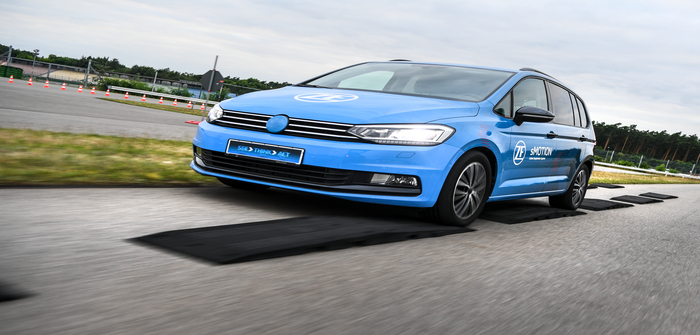ZF has presented its sMotion active suspension system, which uses actuators to control all wheel movements independently to virtually eliminate all body movements and ill effects of road imperfections. Although the system can be applied to any passenger car, it is especially beneficial to AVs, where it will mean passengers don’t necessarily have to pay attention to the road to avoid motion sickness.
The sMotion system features a compact electric motor-pump with integrated electronics that operates as a bi-directional actuator on each wheel. Based on data from environmental sensors such as cameras, these actuators can raise and lower the shock absorber piston rod to control each wheel individually.
That way, the system can counteract body roll in corners and lane changes. It can also detect road conditions such as potholes in advance, and prepare the actuators, allowing the wheel to remain at the height of the road surface instead of dropping down into the pothole and causing a jolt, as would be the case with a conventional shock absorber. sMotion also features dynamic ground clearance for each axle or side, as well as for the entire undercarriage.
This fine control of the suspension enables occupants in AVs to stop focusing on the road without the danger of suffering from motion sickness. Being able to concentrate on reading materials, a tablet or a phone for example, can truly make a car into a mobile office.
“When it comes to the development of highly automated and autonomous driving, the chassis plays a key role,” said Dr Holger Klein, head of ZF’s car chassis technology division.
“Because by the time the autopilot takes over the wheel, all passengers want to be completely relaxed and unaware of the vehicle’s movement, regardless of what is happening on the road. Our sMotion fully active chassis system can fulfil this desire.”
Higher-frequency bumps are also smoothed out with the sMotion system with a second technology, a separate hydraulic control path. This feature compensates for higher-frequency bumps caused by minor unevenness in the road surface, such as manhole covers, transverse joints, rough asphalt or gravel.
In addition, the ZF technology can contribute to V2X, as data about the road condition is transferred to the cloud. That way, it can be used to inform vehicles following behind, and agencies such as road maintenance authorities.
By Illya Verpraet


